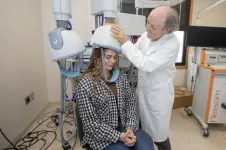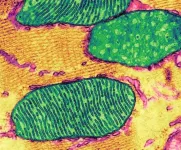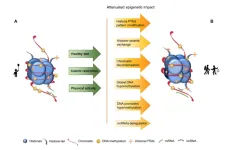(Press-News.org) Artificial intelligence. Gene editing. mRNA vaccines. It’s safe to say the past few decades have felt like the next big wave of medicine. However, what continues to be needed in virtually every field is a personalized approach to care.
That’s certainly needed when it comes to using transcranial magnetic stimulation (TMS) to treat depression, said Medical University of South Carolina Distinguished University Professor Mark George, M.D.
TMS uses a magnet to increase brain activity in a region of the brain known as the dorsolateral prefrontal cortex to treat clinical depression. George is a pioneer in the field, whose work helped TMS to gain approval in 2008 from the U.S. Food and Drug Administration.
TMS can offer a lifeline for those whose depression does not respond to antidepressants.
“In the U.S., at any moment,1 in 20 people is depressed in some capacity,” said George. “About 60% respond well to therapy and medication, and another 20% respond when switched to an alternative medication. But for the remaining 20%, finding an effective drug treatment becomes vanishingly slim.”
By the second week of TMS treatment, most of these patients who have not responded to medications are experiencing fewer depressive symptoms. By the end of the six-week cycle, depression is resolved in about one-third of patients and is decreased in another third. Unfortunately, one third do not respond.
George is looking to better those numbers by personalizing TMS.
“In treating depression with TMS, it’s been standard to target one specific region, but this still leaves some patients who don’t improve,” he said. “We now know there are different kinds of depression. The almost Holy Grail in psychiatry would be, based on a patient’s symptoms, to say ‘You should get TMS, and we should target this part of the brain for best results.’”
In a study recently published in JCI Insight, an international team led by George and Abraham Zangen of the Ben-Gurion University of the Negev took an important step in this direction. The multi-site study showed that using TMS to stimulate activity in another brain region, the medial prefrontal cortex, could also treat depression. It also sets the stage for predicting which depressive symptoms would respond best to targeting each region. The study was funded by BrainsWay Ltd.
Symptoms of depression can and do vary widely from person to person, so researchers collected a variety of depression and anxiety measures for each patient before treatment. The researchers used the decreases in these types of symptoms to gauge how effective the new TMS target was at treating depression compared to the approved target. However, they also examined these decreases to learn which depressive symptoms responded best to which target. To get even more data for making these predictions, EEG brain activity in the prefrontal cortex was also collected during the first treatment session.
After all of the baseline information was collected, each patient was assigned to receive one of the two TMS treatments (medial or dorsolateral), undergoing a full six weeks of treatments. Outcomes for both treatments were very similar: responses were seen in 61% of those receiving the approved treatment and 64% of those treated with the new medial prefrontal TMS target.
“The treatment options were what we would call near equivalent,” said George. “Having more locations and options is always better in medicine.”
What George found most exciting were the links between the pre-treatment symptoms and brain activity and the type of treatment given.
Patients who had a combination of high baseline depression and anxiety measures responded better to the standard TMS treatment, while those with low baseline measures responded best to TMS targeting the new medial prefrontal site.
“The current study helped us to understand which symptom profiles might respond best to the targeting of each brain region,” said George. “In the next study, we will tailor treatment to participants’ symptom profiles to see if outcomes improve.”
This study is a first but important step in the direction of individualized medicine and refinement of the TMS technique. Improving treatment options for depression that does not respond to antidepressants could improve the lives of millions, allowing them to return to work, enjoy time with their loved ones and live their best life.
“For the 20% of people who don’t recover, who lead lives of despair, there are treatments like this that can work and do work,” said George. “People should not settle for less than getting their lives back.”
And George won’t settle until he personalizes and refines TMS to reach more of them.
# # #
About MUSC
Founded in 1824 in Charleston, MUSC is the state’s only comprehensive academic health system, with a unique mission to preserve and optimize human life in South Carolina through education, research and patient care. Each year, MUSC educates more than 3,200 students in six colleges – Dental Medicine, Graduate Studies, Health Professions, Medicine, Nursing and Pharmacy – and trains more than 900 residents and fellows in its health system. MUSC brought in more than $298 million in research funds in fiscal year 2022, leading the state overall in research funding. MUSC also leads the state in federal and National Institutes of Health funding, with more than $220 million. For information on academic programs, visit musc.edu.
As the health care system of the Medical University of South Carolina, MUSC Health is dedicated to delivering the highest-quality and safest patient care while educating and training generations of outstanding health care providers and leaders to serve the people of South Carolina and beyond. Patient care is provided at 16 hospitals (includes owned and equity stake), with approximately 2,700 beds and four additional hospital locations in development; more than 350 telehealth sites and connectivity to patients’ homes; and nearly 750 care locations situated in all regions of South Carolina. In 2022, for the eighth consecutive year, U.S. News & World Report named MUSC Health University Medical Center in Charleston the No. 1 hospital in South Carolina. To learn more about clinical patient services, visit muschealth.org.
MUSC has a total enterprise annual operating budget of $5.1 billion. The nearly 26,000 MUSC family members include world-class faculty, physicians, specialty providers, scientists, students, affiliates and care team members who deliver groundbreaking education, research, and patient care.
END
Stimulating hope: Personalizing treatment options for depression
Medical University of South Carolina study identifies a second target for treating depression with transcranial magnetic stimulation and shows that each target alleviates a different set of symptoms.
2023-05-10
ELSE PRESS RELEASES FROM THIS DATE:
Gene p16 drives colorectal cancer emerging as a target for potential therapies
2023-05-10
Colorectal cancer is the fourth most common and second deadliest cancer. How colorectal cancer develops is not well understood, but a team led by researchers at Baylor College of Medicine reports in the Journal of Experimental & Clinical Cancer Research that silencing the gene p16, even though the DNA itself does not change, can drive colorectal cancer progression in animal models. The researchers also revealed a strategy that reduced tumor growth and improved survival in tumor-bearing mice, opening new possibilities for future targeted therapies in patients with gene p16 alterations.
“Years of research have shown ...
New database offers insight into consequences of language loss
2023-05-10
New database offers insight into consequences of language loss
Languages, like animal species, can go extinct. More than half of the world’s approximately 7,000 signed and spoken languages are currently endangered. And without intervention they are likely to become extinct, meaning nobody will speak or sign them any longer.
While language loss is happening across the world, the costs vary strikingly in different places, according to a new study co-authored by Yale linguist Claire Bowern. Regions where all Indigenous language are endangered — including parts of South America and the United States — ...
Bigger isn’t always better: Size of research teams does not equate to better research outcomes, finds new study
2023-05-10
Having a large research team isn’t linked to producing higher quality research, finds a new study from the University of Surrey which analysed data from 1.4 million academic papers.
Professor Sorin Krammer, lead author of the study and Professor of Strategy and International Business at the University of Surrey, said:
“Despite the prevalence of large teams in research, there is still a lack of a good understanding of how their size and diversity affects their performance.”
“Our ...
The acute problem of chronic disease
2023-05-10
In medicine and science, the term “pathogenesis” describes the origin and development of disease. There is not, however, a broadly accepted term to describe the other half of the equation: the process of healing and recovery.
In a new and far-reaching paper, published May 10, 2023 in the journal Mitochondrion, Robert K. Naviaux, MD, PhD, professor of Medicine, Pediatrics and Pathology at UC San Diego School of Medicine, proposes both a term and, more importantly, outlines the array of processes and players, beginning with cellular mitochondria, that drive the healing process – and whose dysfunction underlies chronic illnesses from diabetes ...
An epigenetic approach to modulating aging with nutrition and exercise
2023-05-10
“In this review, we describe how aging impacts epigenetics and how nutrition and physical exercise can positively impact the aging process, from an epigenetic point of view.”
BUFFALO, NY- May 10, 2023 – A new review paper was published in Aging (listed by MEDLINE/PubMed as "Aging (Albany NY)" and "Aging-US" by Web of Science) Volume 15, Issue 8, entitled, “How can we modulate aging through nutrition and physical exercise? An epigenetic approach.”
The World Health Organization predicts that by 2050, 2.1 billion people worldwide ...
APL Photonics selects recipient for 2022 Future Luminary Award
2023-05-10
MELVILLE, N.Y., May 10 – The University of Arizona’s Husain Alqattan is the recipient of the APL Photonics 2022 Future Luminary Award for his work in utilizing pulse shaping and waveform synthesis to control electron motion and open the door for ultrafast electronics that process data at unprecedented speeds.
The winning paper, “Attosecond light field synthesis,” was published in the April 2022 issue of APL Photonics. In it, Alqattan and his team used an attosecond light ...
Using AI to predict important measure of heart performance
2023-05-10
Coronary heart disease is the leading cause of adult death worldwide. The coronary angiography procedure provides the clinical standard diagnostic assessment for nearly all related clinical decision-making, from medications to coronary bypass surgery. In many cases, quantifying left ventricular ejection fraction (LVEF) at the time of coronary angiography is critical to optimize clinical decision-making and treatment decisions, particularly when angiography is performed for potentially life-threatening acute coronary syndromes (ACS).
Since the left ventricle is the heart’s pumping center, measuring the ejection fraction in the chamber provides critical information about the percentage ...
Bleeding after image-guided breast biopsies: Discontinuing vs. maintaining antithrombotic therapy
2023-05-10
Leesburg, VA, May 10, 2023—According to an accepted manuscript published in ARRS’ own American Journal of Roentgenology (AJR), frequencies of imaging-apparent and palpable hematoma were not significantly different between patients temporarily discontinuing versus maintaining antithrombotic therapy (AT).
“The findings support safety of continuing AT during breast core-needle biopsy (CNB),” wrote lead researcher Melissa Reichman, MD, of Weill Cornell Medicine at New York-Presbyterian ...
Ohio State professor elected to National Academy of Sciences
2023-05-10
COLUMBUS, Ohio - An Ohio State University astronomy professor has been elected to the National Academy of Sciences, one of the highest honors a scientist can receive in the U.S.
David Weinberg, Distinguished University Professor and chair of astronomy, is among 120 new members and 23 international members from 13 countries who were inducted this year in recognition of distinguished and continuing achievement in original research inside their chosen field.
“I have been lucky to have great students and great colleagues throughout ...
New Cleveland Clinic research links immune cell receptors to asthma, inflammatory lung disease
2023-05-10
CLEVELAND - Inhibiting a protein on the surface of immune cells could offer new strategies for treating severe asthma, Cleveland Clinic researchers found.
Researchers discovered a new way a protein called MCEMP1 contributes to severe inflammation in the airway and lungs. The discovery, published in Nature Communications, provides critical information for developing therapeutic interventions to treat long-term lung conditions, including asthma, on a biological level.
The study was conducted in a lab led by Jae Jung, PhD, chair ...
LAST 30 PRESS RELEASES:
Making lighter work of calculating fluid and heat flow
Normalizing blood sugar can halve heart attack risk
Lowering blood sugar cuts heart attack risk in people with prediabetes
Study links genetic variants to risk of blinding eye disease in premature infants
Non-opioid ‘pain sponge’ therapy halts cartilage degeneration and relieves chronic pain
AI can pick up cultural values by mimicking how kids learn
China’s ecological redlines offer fast track to 30 x 30 global conservation goal
Invisible indoor threats: emerging household contaminants and their growing risks to human health
Adding antibody treatment to chemo boosts outcomes for children with rare cancer
Germline pathogenic variants among women without a history of breast cancer
Tanning beds triple melanoma risk, potentially causing broad DNA damage
Unique bond identified as key to viral infection speed
Indoor tanning makes youthful skin much older on a genetic level
Mouse model sheds new light on the causes and potential solutions to human GI problems linked to muscular dystrophy
The Journal of Nuclear Medicine ahead-of-print tip sheet: December 12, 2025
Smarter tools for peering into the microscopic world
Applications open for funding to conduct research in the Kinsey Institute archives
Global measure underestimates the severity of food insecurity
Child survivors of critical illness are missing out on timely follow up care
Risk-based vs annual breast cancer screening / the WISDOM randomized clinical trial
University of Toronto launches Electric Vehicle Innovation Ontario to accelerate advanced EV technologies and build Canada’s innovation advantage
Early relapse predicts poor outcomes in aggressive blood cancer
American College of Lifestyle Medicine applauds two CMS models aligned with lifestyle medicine practice and reimbursement
Clinical trial finds cannabis use not a barrier to quitting nicotine vaping
Supplemental nutrition assistance program policies and food insecurity
Switching immune cells to “night mode” could limit damage after a heart attack, study suggests
URI-based Global RIghts Project report spotlights continued troubling trends in worldwide inhumane treatment
Neutrophils are less aggressive at night, explaining why nighttime heart attacks cause less damage than daytime events
Menopausal hormone therapy may not pose breast cancer risk for women with BRCA mutations
Mobile health tool may improve quality of life for adolescent and young adult breast cancer survivors
[Press-News.org] Stimulating hope: Personalizing treatment options for depressionMedical University of South Carolina study identifies a second target for treating depression with transcranial magnetic stimulation and shows that each target alleviates a different set of symptoms.




